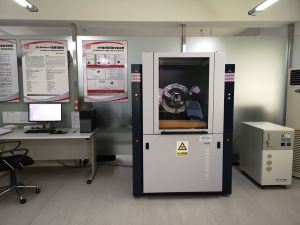Manufacturer: Bruker (Germany)
Equipment model: D8 Advance
Location: Room 205 of Science and Technology Building
Person-in-charge: Wang Lili
Tel.: 62332598-6206
Main functions:
This device is currently the most advanced X-ray diffractometer system in the world. Its design precision, and hardware and software functions are comprehensive. In addition, it can accurately perform phase retrieval analysis, phase quantitative analysis, cell parameter calculation and solid solution analysis, as well as grain size and crystallinity analysis of metal and non-metal polycrystalline powder specimens. The instruments involved include ceramic X-ray tube, X-ray high-voltage generator, high-precision goniometer, LynxEye one-dimensional array detector, computer control system, data processing software, related application software and circulating water device. It is widely used in the fields of physics, chemistry, pharmacy, metallurgy, polymer materials, life sciences and materials science. Furthermore, it can be adopted for analyzing the phase identification of clay minerals, alloys, ceramics, foods, medicines, biomaterials, building materials, polymer materials, semiconductor materials, superconducting materials, nano materials, superlattice materials and magnetic materials. It can be used to analyze materials that are flaky, in bulk and powder solids such as single crystal, polycrystals, fibers, and films, and can provide accurate and reliable data for scientific research.
Main technical parameters:
1. Light tube type: ceramic X-ray tube, Cu target and other targets (optional, e.g. Mo/Co target)
2. Goniometer: high-precision stepper motorized double-circle goniometer
Scanning method: q/q goniometer
Scanning angle range: 2θ = -10° ~ 168°
Readable min. step size: 0.0001°
Angle reproducibility: 0.0001°
3. Detector: LynxEye one-dimensional array detector
Max. count: ≥1 × 109 cps
Background: <0.1 cps
Main applications:
1. Qualitative phase analysis (powder, block, film, etc.)
2. Quantitative phase analysis
3. Crystallinity determination
4. Grain size determination
5. Crystal structure analysis
6. Crystal orientation analysis
7. Texture analysis
8. Microscopic strain analysis
9. Residual stress determination
Laboratory appointment:
http://202.204.49.249/Equipment/Show?Id=fc0e4c1f-81cb-4b74-9508-13b77b093bc7